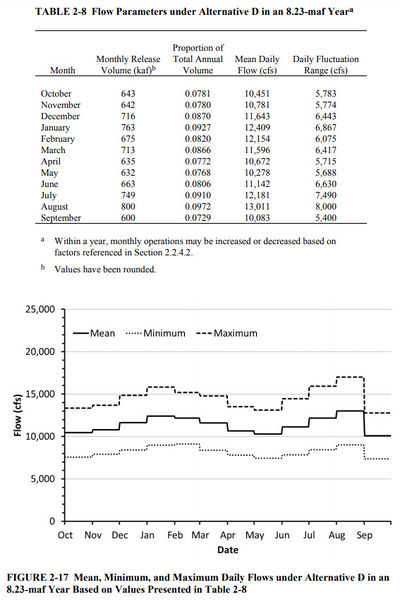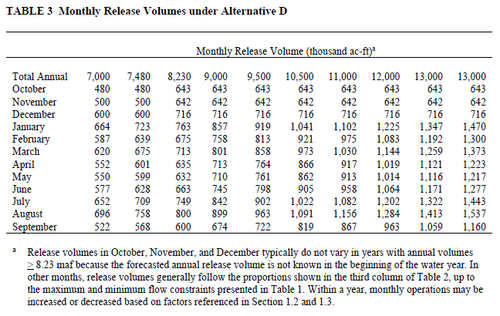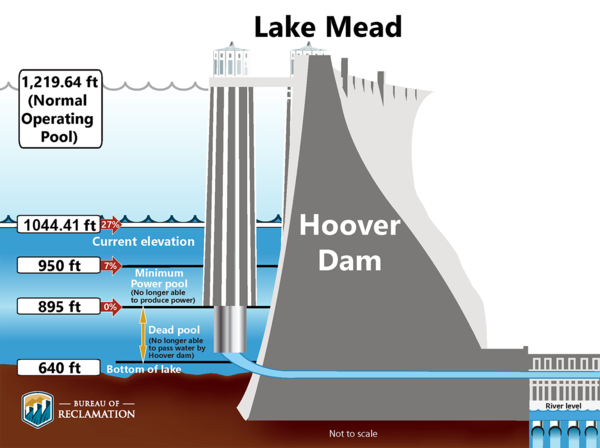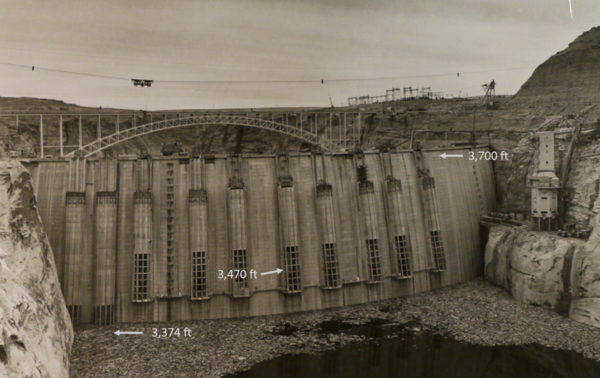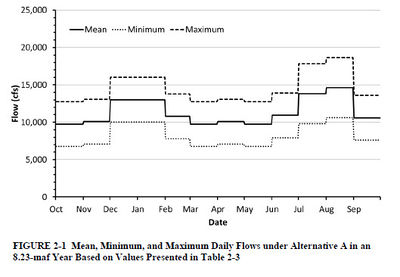Difference between revisions of "GCDAMP Glen Canyon Dam"
Cellsworth (Talk | contribs) |
Cellsworth (Talk | contribs) |
||
| (11 intermediate revisions by the same user not shown) | |||
| Line 58: | Line 58: | ||
== '''Glen Canyon Monthly Operational Call''' == | == '''Glen Canyon Monthly Operational Call''' == | ||
| + | The DOI also will conduct monthly Glen Canyon Dam operational coordination meetings or calls with the DOI bureaus (USGS, NPS, FWS, BIA, and Reclamation), WAPA, AZGFD, and representatives from the Basin States and the UCRC. Each DOI bureau will provide updates on the status of resources and dam operations. In addition, WAPA will provide updates on the status of the Basin Fund, projected purchase power prices, and its financial and operational considerations. These meetings or calls are intended to provide an opportunity for participants to share and obtain the most up-to-date information on dam operational considerations and the status of resources (including ecological, cultural, Tribal, recreation, and the Basin Fund). One liaison from each Basin State and from the UCRC will be allowed to participate in the monthly operational coordination meetings or calls. [https://ltempeis.anl.gov/documents/docs/LTEMP_ROD.pdf] | ||
| + | |||
| + | *[[Media:202503_Information.pdf| March 2025 Operations call]] | ||
| + | *[[Media:202502_Information.pdf| February 2025 Operations call]] | ||
| + | *[[Media:202501_Information.pdf| January 2025 Operations call]] | ||
| + | *[[Media:202412_Information.pdf| December 2024 Operations call]] | ||
| + | *[[Media:202411_Information.pdf| November 2024 Operations call]] | ||
| + | *[[Media:202410_Information.pdf| October 2024 Operations call]] | ||
*[[Media:202409_Information.pdf| September 2024 Operations call]] | *[[Media:202409_Information.pdf| September 2024 Operations call]] | ||
*[[Media:202408_Information.pdf| August 2024 Operations call]] | *[[Media:202408_Information.pdf| August 2024 Operations call]] | ||
| Line 70: | Line 78: | ||
*[[Media:202311_Information.pdf| November 2023 Operations call]] | *[[Media:202311_Information.pdf| November 2023 Operations call]] | ||
*[[Media:102023_Information.pdf| October 2023 Operations call]] | *[[Media:102023_Information.pdf| October 2023 Operations call]] | ||
| − | |||
| − | |||
| − | |||
| − | |||
| − | |||
| − | |||
[[Archived Glen Canyon Monthly Operations Call slides]] | [[Archived Glen Canyon Monthly Operations Call slides]] | ||
| + | |||
| + | |- | ||
| + | ! <h2 style="margin:0; background:#cedff2; font-size:120%; font-weight:bold; border:1px solid #a3b0bf; text-align:left; color:#000; padding:0.2em 0.4em;"> Critical Reservoir Elevations at Powell and Mead</h2> | ||
| + | |- | ||
| + | |style="color:#000;"| | ||
== '''USBR Monthly/Annual Reports''' == | == '''USBR Monthly/Annual Reports''' == | ||
| Line 84: | Line 91: | ||
*[https://www.usbr.gov/uc/water/rsvrs/ops/monthly_summaries/index.html Monthly Summaries] | *[https://www.usbr.gov/uc/water/rsvrs/ops/monthly_summaries/index.html Monthly Summaries] | ||
*[https://www.usbr.gov/uc/water/rsvrs/ops/aop/index.html Annual Operating Plans for Colorado River reservoirs] | *[https://www.usbr.gov/uc/water/rsvrs/ops/aop/index.html Annual Operating Plans for Colorado River reservoirs] | ||
| − | |||
| − | |||
| − | |||
| − | |||
| − | |||
| − | |||
| − | |||
| − | |||
| − | |||
| − | |||
| − | |||
| − | |||
| − | |||
|- | |- | ||
| Line 156: | Line 150: | ||
*Add release data to Western’s web site and provide periodic reports to the TWG on the operation of Glen Canyon Dam and, | *Add release data to Western’s web site and provide periodic reports to the TWG on the operation of Glen Canyon Dam and, | ||
*Continue efforts to for better coordination between Reclamation and Western regarding the scheduling and operation of Glen Canyon Dam.[https://www.wapa.gov/regions/CRSP/PlanProject/Pages/glen-canyon-operations.aspx] | *Continue efforts to for better coordination between Reclamation and Western regarding the scheduling and operation of Glen Canyon Dam.[https://www.wapa.gov/regions/CRSP/PlanProject/Pages/glen-canyon-operations.aspx] | ||
| + | |||
| + | [[File:Glen_Canyon_critical_elevations.png|center|600px]] | ||
| + | |||
| + | [[File:Mead_critical_elevations.png|center|600px]] | ||
| + | |||
| + | [[File:Glen_Canyon_Dam_filling.png|center|600px]] <br> | ||
| + | The back of Glen Canyon Dam as Lake Powell was filling showing the 8 penstocks on the right and the two river outlet works on the left. | ||
| + | |||
| + | == '''Report to Congress Regarding Operations of Glen Canyon Dam'''[https://www.usbr.gov/uc/DocLibrary/reports.html] == | ||
| + | *[https://www.usbr.gov/uc/DocLibrary/Reports/GlenCanyonDam/20210500-GlenCanyonDam-ReportCongress-2020-2021-508-UCRO.pdf Report to Congress - Water Year 2020-2021 ] | ||
| + | *[https://www.usbr.gov/uc/DocLibrary/Reports/GlenCanyonDam/20210400-GlenCanyonDam-ReportCongress-2019-2020-508-UCRO.pdf Report to Congress - Water Year 2019-2020] | ||
| + | *[https://www.usbr.gov/uc/DocLibrary/Reports/GlenCanyonDam/20200600-GlenCanyonDam-ReportCongress-2018-2019-508-UCRO.pdf Report to Congress - Water Year 2018-2019] | ||
| + | *[https://www.usbr.gov/uc/DocLibrary/Reports/GlenCanyonDam/20180800-GlenCanyonDam-ReportCongress-2017-2018-508-UCRO.pdf Report to Congress - Water Year 2017-2018] | ||
| + | *[https://www.usbr.gov/uc/envdocs/reports/GCDam/GC-Report-to-Congress2016-2017.pdf Report to Congress - Water Year 2016-2017 ] | ||
| + | *[[Media:Years 2015-16 GC Report to Congress FINAL.pdf| 2015-2016 Report to Congress ]] | ||
| + | *[https://www.usbr.gov/uc/DocLibrary/Reports/GlenCanyonDam/20150800-GlenCanyonDam-ReportCongress-2014-2015-508-UCRO.pdf 2014-2015 Report to Congress ] | ||
| + | *[http://www.usbr.gov/uc/envdocs/reports/GCDam/GC-Report-to-Congress2013-2014.pdf 2013-2014 Report to Congress ] | ||
| + | *[http://www.usbr.gov/uc/envdocs/reports/GCDam/GC-Report-to-Congress2010-2011.pdf 2010-2011 Report to Congress ] | ||
| + | *[http://www.usbr.gov/uc/envdocs/reports/GCDam/GC-Report-to-Congress1999-2001.pdf 1999-2001 Report to Congress ] | ||
| + | *[http://www.usbr.gov/uc/envdocs/reports/GCDam/GC-Report-to-Congress1998-1999.pdf 1998-1999 Report to Congress ] | ||
|} | |} | ||
Latest revision as of 16:57, 4 April 2025
|
Operations of Glen Canyon DamThe LTEMP Record of Decision (ROD) on the operation of Glen Canyon Dam was signed on December 15, 2016. It changed operations at Glen Canyon from the 1996 ROD that implemented the MLFF flow regime.
Maximum non-experimental flows:
Daily range:
Ramp rates:
|
| Current Status |
Current Operations | Inflow Forecasts and Model Projections |
|---|
|
|
